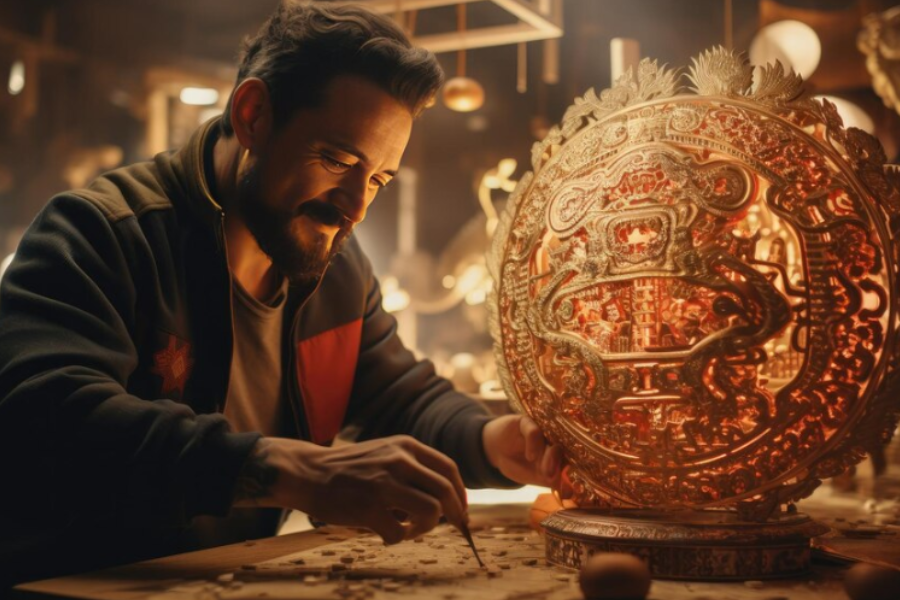Käämyäjä: Weaving Stories of Finnish Heritage Through Art
In the captivating landscape of global traditions, some customs captivate with their distinctiveness. One such phenomenon is “Käämyäjä,” a traditional art form steeped in rich history and cultural significance, evolving through time while enchanting audiences worldwide.
Roots and Cultural Importance
The term “Käämyäjä” finds its origins in ancient Finnish ceremonies, where it held profound spiritual meaning.”Käämyäjä,” which comes from the Finnish words “kaama” (to coil or twist) and “ja” (an artist or craftsperson), refers to much more than only artistic ability.It serves as a medium for conveying symbolic messages about spiritual beliefs, community values, and historical narratives. These ceremonies, integral to Finnish culture, utilize “Käämyäjä” to preserve traditions, ensuring they are passed down through generations. The name itself encapsulates various meanings that reflect the essence of Finnish identity.
Transformation of Käämyäjä
Originally emerging as simple sculptures and ritualistic objects, “Käämyäjä” has evolved into diverse forms while maintaining its core essence. Over centuries, it transitioned from ceremonial artifacts to everyday artistic expressions, demonstrating its adaptability and resilience. Initially rooted in spiritual and religious contexts, this art form has permeated various aspects of Finnish life, from home decor to functional items. This evolution highlights the interplay between tradition and innovation within Finnish culture.
Craftsmanship and Symbolism
The meticulous craftsmanship involved in creating “Käämyäjä” pieces showcases the dedication of skilled artisans committed to preserving this tradition. The creation process involves careful selection of materials and intricate pattern design. Artisans utilize traditional materials such as bone, leather, and wood, employing techniques handed down through generations. This meticulous approach not only ensures authenticity and quality but also imbues each piece with deep symbolic significance. A “Käämyäjä” creation is not just art; it is a narrative, rich with cultural heritage. The intricate motifs often depict tales from Finnish mythology, folklore, and spiritual beliefs, fostering a connection between contemporary viewers and their cultural lineage.
Contemporary Influences and Interpretations
In modern times, “Käämyäjä” has embraced innovative ideas while staying true to its roots. Contemporary artists experiment with new materials and techniques, breathing new life into this ancient art form. This fusion of tradition and modern creativity enhances the relevance of “Käämyäjä” in today’s cultural landscape. While traditional pieces maintain their historical value, contemporary artists are discovering fresh avenues for expression within this framework. New styles have emerged, blending age-old techniques with modern aesthetics, appealing to a broader audience while preserving the art form’s essence. Moreover, advancements in technology have facilitated the dissemination of “Käämyäjä,” allowing enthusiasts worldwide to engage with and appreciate this unique art form.
Community Engagement and Collaboration
“Käämyäjä” fosters collaboration within Finnish communities, nurturing a sense of belonging and shared identity. Individuals of all ages unite to preserve and promote this cultural heritage, strengthening community bonds. Workshops and gatherings in rural areas provide platforms for sharing knowledge and celebrating traditional customs. These communal events not only sustain the “Käämyäjä” tradition but also instill pride and a sense of belonging among participants. Additionally, numerous organizations are dedicated to preserving and raising awareness about “Käämyäjä,” organizing exhibitions, workshops, and educational programs to ensure its survival for future generations.
Challenges and Preservation Initiatives
Despite its rich heritage, “Käämyäjä” faces challenges in the contemporary world. Economic shifts, demographic changes, and the need for cultural preservation pose threats to its continuity. However, communities and organizations committed to safeguarding this beloved art form have initiated efforts to document, promote, and educate others about it. A significant concern is the dwindling number of skilled artisans capable of continuing this craft. To address this, programs have been established to mentor and train aspiring craftspeople, ensuring the skills and knowledge necessary for creating “Käämyäjä” are passed down. Furthermore, efforts are underway to digitize and catalog existing “Käämyäjä” artifacts, enhancing accessibility and safeguarding them for future generations. By promoting awareness of “Käämyäjä”’s cultural significance and engaging with relevant organizations, individuals can help protect this integral aspect of Finnish heritage.
Ongoing Evolution and Future Outlook
In the hands of contemporary artists, “Käämyäjä” continues to evolve, with fresh ideas and meanings enriching its narrative. As it bridges the past and present, it stands as a testament to the enduring power of cultural expression. The challenges faced in preserving “Käämyäjä” are significant, yet they are surmountable. By fostering collaboration, embracing innovation, and encouraging community involvement, stakeholders can ensure this art form remains a vibrant and essential part of Finnish culture for generations to come.
Summary
Käämyäjä is a traditional Finnish art form with deep cultural roots and significant spiritual meaning. Originating from ancient ceremonies, the term combines the Finnish words for “to coil” and “craftsperson,” highlighting its importance in conveying cultural narratives and values. Over time, Käämyäjä has evolved from ceremonial objects to versatile works of art, reflecting the adaptability of Finnish culture.
Craftsmanship plays a vital role in Käämyäjä, with artisans using traditional materials and techniques to create pieces rich in symbolism and meaning, often drawing from Finnish mythology and folklore. In contemporary times, modern artists are experimenting with new materials and methods, merging tradition with innovation to keep Käämyäjä relevant.
Community engagement is essential for preserving this art form, as people work together to celebrate and protect their cultural heritage. However, Käämyäjä faces challenges, such as a decline in skilled artisans and the need for cultural preservation. Efforts are underway to document, promote, and educate about Käämyäjä, ensuring its survival for future generations. Overall, Käämyäjä exemplifies the enduring strength of cultural expression and the importance of maintaining traditional practices in a modern context.
FAQs:
1. What is Käämyäjä?
Käämyäjä is a traditional Finnish art form with origins in ancient ceremonies, known for its spiritual significance and cultural narratives.
2. What does the term Käämyäjä mean?
The term is derived from Finnish words: “kaama,” meaning “to coil or twist,” and “ja,” meaning “an artist or craftsperson.” It reflects the art form’s connection to cultural expression.
3. How has Käämyäjä evolved over time?
Originally focused on ceremonial objects, Käämyäjä has transformed into various artistic expressions used in everyday life, showcasing its adaptability within Finnish culture.
4. What materials are used in Käämyäjä craftsmanship?
Artisans typically use traditional materials like bone, leather, and wood, employing techniques passed down through generations to create intricate designs.
5. How does Käämyäjä reflect Finnish culture?
Käämyäjä pieces often depict stories from Finnish mythology and folklore, preserving cultural heritage and promoting a connection to the past for future generations.
6. What challenges does Käämyäjä face today?
Käämyäjä faces challenges such as a decline in skilled artisans and the impact of modernization on cultural practices, posing risks to its preservation.
7. How is Käämyäjä being preserved?
Community groups and organizations are working to document, promote, and educate others about Käämyäjä, while training new artisans to ensure the craft continues.
8. Can modern artists contribute to Käämyäjä?
Yes, contemporary artists are exploring new materials and techniques, merging traditional elements with modern aesthetics, helping Käämyäjä remain relevant in today’s culture.
9. How can people get involved in preserving Käämyäjä?
Individuals can support Käämyäjä by participating in community workshops, engaging with preservation organizations, and spreading awareness about its cultural significance.
10. Why is Käämyäjä important for Finnish identity?
Käämyäjä embodies the rich cultural heritage of Finland, serving as a symbol of community, history, and artistic expression that connects people to their roots.
Stay in touch to get more news & updates on Newshunter!






